For weeks it has been painful to leave the house. I have spent many hours standing hunched at bus stops, the wind whipping mercilessly at my hair. My hands have even started cracking under the cold, with little cuts appearing at the joints. This week we had snow blizzards swirling round the city.
And then today. Today the sun came out. And so did the bees.
This is the first time I’ve seen them flying since November. It was VERY exciting. They must have been desperate to feel the sun, to collect food, to poop. A buzz of excitement, of purpose, could be heard outside each hive. Lots to do!
Terrible photos I know, but Emma and Drew were not there. Below you can see some yellow pollen on the legs of the lower bee. Several of the bees were bringing back similarly garish loads. Does anyone know what this yellow pollen is? Ian suggested daffodils. I had a look on the Bristol Beekeepers Association’s interactive pollen guide (access by clicking on ‘Pollen guide’ along their top navigation menu) and broccoli and blue crocus look a similar colour.
Encouraged by the warmth, with the help of some excellent assistants I removed the chicken-wire around our hives, which was protecting them against woodpeckers. Now that the ground is softer and a few more insects about, hopefully woodpeckers will be going for easier targets.
I probably haven’t mentioned yet that recently Emma and I bought a hive from a beekeeper who has given up. So we now have two in place, lined up next to each other. I checked the fondant and the bees still had some left. It was still a little too cold for a proper inspection: we had coats on and inspecting should be done in t-shirt weather.
Beautiful flowers are out around Ealing apiary, including blue, white and pink hyacinths.
We also had some cake. This is a pistacho one, which we had today…
And this is a simnel cake, which is a fruit cake made with ground almonds, covered with marzipan and then lightly grilled – quite a bizarre experience for me, grilling a cake. The marzipan balls represent the eleven apostles, as it’s a cake traditionally eaten to celebrate Easter.
Perhaps spring is here at last and us beekeepers can start doing some actual beekeeping, rather than just talking about it. It has been a hard, long winter and many experienced beekeepers have lost several hives. I feel very grateful that our little bees have come through safely so far.

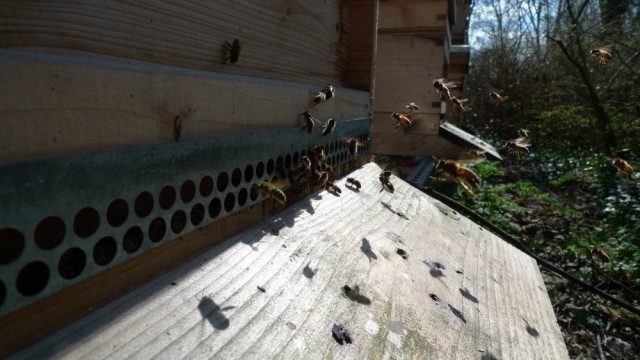
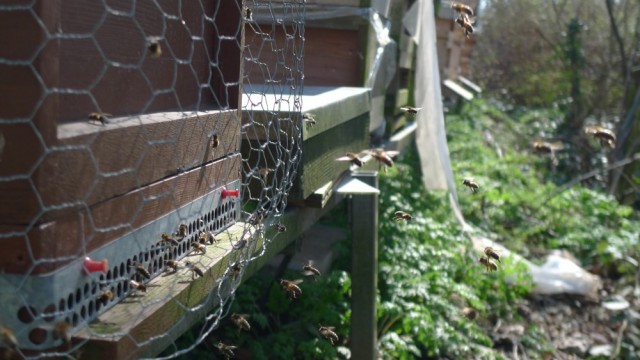
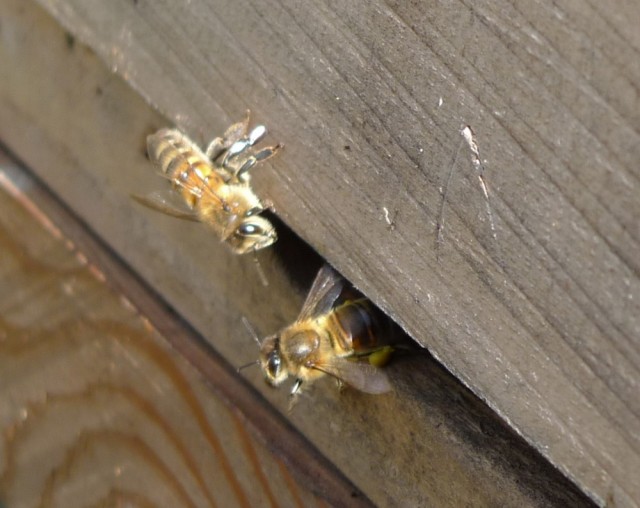

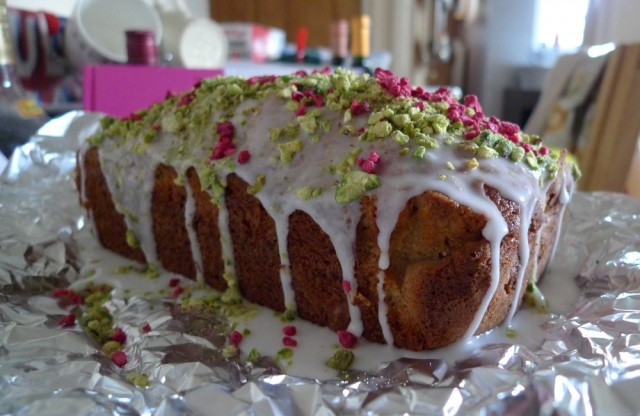
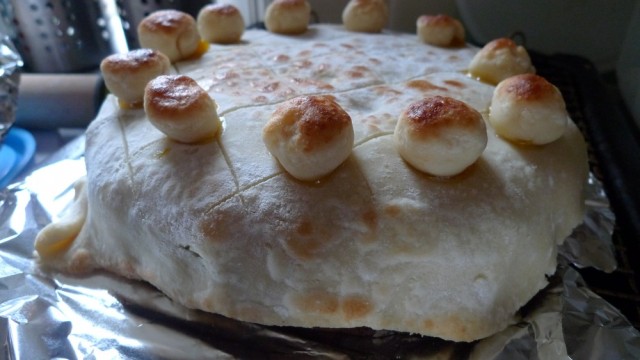
Hurray for Spring!! Tell everyone at the apiary I said “hello!”
LikeLike
Hurray indeed, will do Deborah!
LikeLike
Yes, no wind today to speak of and I did manage to ditch my coat for a while. We were out orienteering and picnicking, in what actually felt like picnic weather and we saw some bees too. (The furry lining of my wife’s hood seemed to be very attractive to them, can’t think why.)
I know nothing about pollen colour, but yellow flowers about at the moment: celandines, gorse, coltsfoot. I would guess that the first of these would be pretty common on any odd corners of waste ground in London. Do bees go for tree pollens? A lot of trees have catkins fairly early in the year.
LikeLike
Ditching the coat! A warm day indeed. I didn’t quite get that far. It doesn’t always follow that yellow flowers produce yellow pollen – gorse produces brick red pollen. Bees love tree pollen and I’ve seen a lot of white flowered trees out, so perhaps they were visiting those.
LikeLike
I would suggest Crocus or pussy willow
LikeLike
Thanks Jonathan. The Bristol beekeepers pollen guide shows willow as having a slightly darker, murkier yellow pollen than I saw on my bees, but crocus seems about the right colour.
LikeLike
Emily,
The pictures look awesome! It’s great to see them in-flight. Very exciting times indeed!
LikeLike
Thanks Simon. They were really pinging back in and also sitting around the hive walls basking in the sunshine.
LikeLike
A beautiful sight!
LikeLike
Congratulations on bringing your ladies through the awful winter. I hope they are collecting pollen and nectar faster than the queens are laying. No doubt there will be a lot of larvae to feed soon!
I’m not a pollen expert but, in my experience, a lot of plants produce yellow pollen. I would be very surprised if it was broccoli though, with winter just subsiding I doubt any is sprouting much less going to flower. Crocus sounds like the most likely target.
LikeLike
Thanks Laura, I’m not a gardener so I saw that broccoli is meant to be a spring flower but I have no idea how hardy it is. Crocuses are definitely about.
LikeLike
Oh, CAKE!!! The weather is warming and bees are buzzing. Glad to see yours on the move.
LikeLike
CAKE indeed! An essential part of beekeeping.
LikeLike
I am anxious to expand my garden activities to include bee keeping at some point in time so your posts are really fascinating. Thank you for sharing your information.
LikeLike
You’re welcome 🙂
LikeLike
Emily, do you have CCD in the UK? Someone was mentioning you do not, but I questioned their accuracy!
LikeLike
That person was correct, CCD is not officially recognised as a problem here by our National Bee Unit (https://secure.fera.defra.gov.uk/beebase/). They do note that many of the symptoms of CCD are not unlike the result of a heavy varroa infestation which causes absconding – varroa is considered to be the main cause of colony losses here.
You can see data on the winter losses of British beekeepers here: http://www.bbka.org.uk/files/pressreleases/bbka_winter_survival_survey_release_final_14_june_1341499958.pdf. Most colonies here tend to be lost during the winter or early spring rather than throughout the year as I think is the case with CCD?
LikeLike
These are wonderful photos & and a great post! Cheers~
LikeLike
Thanks Cindy! I have been really enjoying your hummingbird photos.
LikeLike
Glad the bees are foraging and the first bee-cake of Spring has been sighted…
LikeLike
He he, many more cakes to come…
LikeLike
Re: daffodil pollen.
I have often wondered why I have never seen bees working daffodils, which seem to produce an abundance of pollen. I have heard an eminent beekeeper state that if your bees are working daffodils you should move them – they are desperate for food! FN Howes (‘Plants and Beekeeping’) states says that daffodils are of some value for early pollen, but are of little cosequence for nectar – a long tongue is needed to reach the ne tray. Daffodils contain alkaloids including lycorine, which protects them from being eaten by rabbits & field mice. A parallel can be drawn with buttercups (again, not normally worked by bees) the pollen of which has been proven to be injurious to bees – this has occurred when cold weather has retarded the flowering of the usual pollen plants.
LikeLike
Thanks Brian, I’ve read some similar info before. It’s a shame as daffodils are popular in cities and I think people assume they’re helping bees. Perhaps they are more useful for long-tongued bumble bees.
LikeLike
How do you stop an iPad ‘correcting text’? In my previous message I wrote ‘a long tongue is needed to reach the nectary’ not ‘ne tray’! ‘cosequence’ =’consequence’ and ‘states says’=’says’!
Incidentally, my bees at home were flying today but I saw no pollen going in. I have, so far, lost 9 out of 20 colonies. I can only hope the remainder survive. They need pollen.
LikeLike
There should be a little ‘x’ you can click on above the suggested correction to stop it happening. Sorry to hear that you’ve lost so many colonies. Is it worth ordering some pollen patties? I’ve not done that with my bees before but have been thinking about it this year.
LikeLike
I have never fed pollen or pollen substitutes but, like you, I have considered doing so this year – I keep hoping the weather will improve.
Thanks for the tip – I now understand!
LikeLike
No probs. Surely the weather must improve soon! I thought the weather couldn’t get worse than last year, but so far this year is proving me wrong.
LikeLike
Lovely photographs, Emily. I’m so pleased to read that all your colonies have come through the winter and have been out gathering pollen. I wonder what your yellow pollen is; according to my guide spring yellow pollen comes from crocus and broccoli, as you say, and hazel and alder. There are certainly plenty of crocuses still flowering. And the cakes look delicious.
LikeLike
Thanks Wendy. I’ve seen lots of hazel about, so that could be a possibility.
LikeLike
It is lovely to see your bees with full pollen sacs. If there are gardens around, flowering quince has a red flower and yellow pollen. Dandelion and red dead nettle are yellow but perhaps a deeper yellow than you are looking for. It’s been a long winter for the bees.
LikeLike
Flowering quince – interesting. Bees don’t usually go for red flowers, but perhaps it has some ultraviolet colouring.
LikeLike
I agree, they seem to go more for blue and white but perhaps they are flowering at a time of year when there is less choice.
LikeLike
Bees collect pollen from red poppies – they don’t see red so the flowers appear black to them.
LikeLike
I’ve read before that some red flowers, such as poppies, have ultraviolet colouring that we can’t see but the bees can, and they’re attracted to that.
LikeLike
Sometimes I can’t decide which I like best about your blog–the bees or the cake?!
LikeLike
The cake photos seem to be popular – perhaps I should take more! Cakes are certainly easier to photograph, they don’t keep flying away once I get them in focus.
LikeLike
Goodness. We had thought your climate slightly milder than ours but it sounds as though you have had the worse winter. Glad your girls made it.
LikeLike
Thanks. This winter has been unusually bad, we don’t usually get snow blizzards in April!
LikeLike
I was wondering if you could tell me, how do bee keepers know how much honey to take from the hives since bees need food over winter? Is it an educated guess based on weather, honey product, health of bees, size of hive? I looked it up and all the answers are so general, like it is a big guess. Most fed sugar syrup too.
LikeLike
Hi Donna. Generally you would try to leave the same amount of honey each year, and then take off any surplus honey above that. How much that amount is will vary according to your geographic location, as winters in some countries last longer than others.
In the UK it’s recommended that the bees will need at least 20kg/40lb of stored honey in the hive (just over one British national super’s worth) to survive the winter, especially if there is a wet spring. A lot of UK beekeepers will harvest any supers in August and overwinter the hive on a single brood box, or perhaps a brood box and one super, feeding the bees sugar syrup during September/October to get them to build up their stores within the brood box. Fondant can be supplied during the winter too.
For the last couple of years, due to bad weather and queen problems, our bees haven’t managed to fill up a super, so we haven’t been able to harvest any honey. In better locations than ours, colonies can produce between around 1-5 supers a year. So we’re rubbish beekeepers from a honey production point of view – but I console myself that we’ve never lost a colony overwinter yet!
Hope this helps.
LikeLike
It helped a lot. I just was curious because I was thinking about it from the bees point of view. It is a lot of work to make honey and I have a tablespoon a day just because I like it. I thought, poor bees if they did not have enough for winter. No where really explained it. Thanks again.
LikeLike
Your question is how much honey to leave rather than how much to take! If there is nectar available, bees will collect it. In a good year (last year was not a good year), they will collect more than they require for their daily needs & to store for the winter. They need 200 lb p.a. of honey for their daily needs before the beekeeper will see a surplus. A colony needs at least 40 lb honey stores for their winter/spring needs. If all the honey in the supers is removed, the remaining stores in the brood box needs to be topped up with sugar syrup (‘strong syrup’: 2 lb sugar in 1 pint of water) to give the equivalent of 40lb honey (in time for the bees to ‘ripen’ it). An estimate of existing stores should be made – a brood frame full of sealed honey would hold about 5 lb. Rather than feed sugar syrup, I leave a super of sealed honey. This winter & spring have been prolonged and bees will need extra feeding. Bees can not process sugar syrup when it is cold and solid food should be used. Fondant should be used. This is available from beekeeping suppliers or from bakers. Beekeepers used to make candy for winter feeding – recipes are given in many beekeeping books – personally, I don’t think it is worth the effort. Bees also need pollen, especially in the spring for brood rearing. Again, pollen patties can be obtained from beekeeping suppliers. I hope this helps.
LikeLike
Thanks very much Brian. Emma and I also try to leave 40lb worth of honey. Unfortunately, last year bad weather and queen problems meant that our bees never managed to fill up any super frames.
LikeLike
The cakes look wonderful. With the weather improving the many flowers of Spring will be a welcome source of resources for bees.
LikeLike